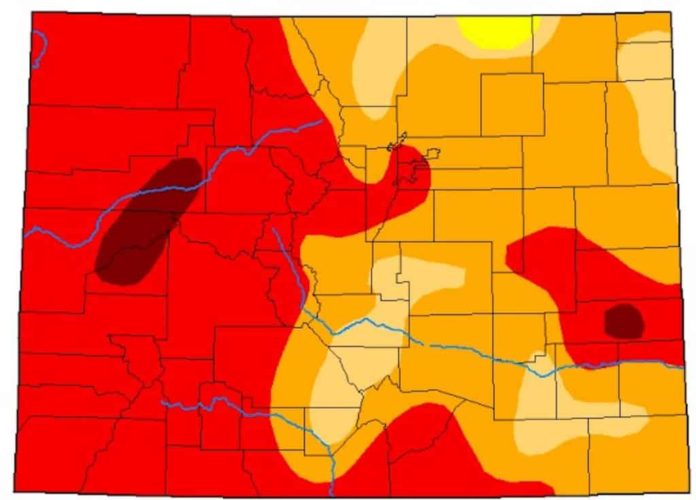A hot, dry summer has only worsened drought conditions in Colorado, particularly west of the Continental Divide.
Every square mile of Eagle County is in “extreme” drought. That’s the second-most severe classification. Portions of Garfield, Mesa and Delta counties are in the worst category, “exceptional” drought.
There isn’t much relief on the immediate horizon.
Erin Walter, a meteorologist at the Grand Junction office of the National Weather Service, said a high-pressure system will move out of the area toward the end of this week. That movement, along with a low-pressure system moving in off the Pacific coast, will create a chance of precipitation starting Oct. 10 and lasting into Oct. 12.
That’s about it, though. Weather forecasters don’t predict the weather with confidence more than about seven days in advance. But the climate prediction arm of the National Oceanographic and Atmospheric Administration is calling a chance for warmer and drier than average conditions for most of the contiguous portion of the U.S.
Fewer red flags?
The good news, Walter said, is that the Western Slope is less likely to have red flag fire weather warnings over the next several days.
Those warnings are issued due to a combination of temperature, relative humidity and strong winds.
Daytime temperatures have been cooler lately, with overnight lows in the 30s, even in the western valley.
Those cooler temperatures have helped ease the area’s wildfire danger, although the region is very dry.
A release in late September of about 1,800 acre feet of water from Homestake Reservoir boosted streamflows, but only for a few days.
John Packer owns Fly Fishing Outfitters in Avon. Packer said the cooler water temperatures have helped fishing conditions. During the heat of August, there was a voluntary river closure for fishing past 2 p.m.
Packer said fish in the river are healthy, for the most part, although low streamflows have bunched the fish together in deeper pools along the river.
The release from Homestake helped move the fish around a bit, Packer said.
Very low flows
But streamflows remain very low.
Holly Loff, the director of the Eagle River Watershed Council, said the Eagle River below Gypsum was recently running at 150 cubic feet per second. Normal flow this time of year is 229 cubic feet per second. The Eagle River at Avon has been running at 58.6 cubic feet per second, 51% of normal.
“It’s scary right now,” Loff said. Loff lives along the river in Gypsum, and said she can see rocks in the middle of the stream that have never before been above water.
Autumn is usually a dry period, although this fall is much drier than normal.
Diane Johnson, the communications and public affairs officer for the Eagle River Water & Sanitation District, said that agency just after Labor Day put out the word to its customers to start winterizing their irrigation systems.
And, while many people plant in the fall, Johnson said this probably isn’t a good year for that, given current dry conditions and the need to conserve water.
But, Walter said, there might be some relief on the horizon.
It hasn’t solidified yet, but Walter said there’s a La Nina advisory for a portion of the equatorial Pacific Ocean about 1,000 miles west of Ecuador.
A La Nina develops with cooler-than-average temperatures in that part of the Pacific. That tends to bring storms through the Pacific Northwest, and that generally benefits the northern Colorado Rockies. The Vail Valley tends to benefit from La Nina patterns, although that isn’t a sure thing.
Conversely, El Nino patterns — with warmer-than-average water temperatures in that part of the Pacific — tends to benefit the southern Rockies, and can bring moisture to the Front Range.
If a La Nina pattern does develop, it has some work to do. A heavy winter is needed to recharge soil moisture, streams and reservoirs throughout the state.
For now, Loff said residents can help the streams by cutting back or stopping their outdoor watering.
“Anybody that really has concerns about the river… can dial back their use,” Loff said. “There’s no real need to water lawns right now — it’s October.”
Johnson noted that this year’s drought is just a continuation of a pattern that’s persisted for this century so far.
“We have a changing climate, and we’ve got more folks living here,” Johnson said. “And the outlook for winter isn’t great.”
Vail Daily Business Editor Scott Miller can be reached at smiller@vaildaily.com.
Credit: Source link































